- Home
- Sustainability
- Creating a society that co-exists with the environment
- Information Disclosure in line with TNFD Recommendations (Biodiversity Conservation)
Information Disclosure in line with TNFD Recommendations (Biodiversity Conservation)
JFR Approach to Natural Capital
Our lives and business activities are supported by food, water, climate stability and other ecosystem services, which are provided by the interactions among diverse living organisms. However, due to the recent deterioration of the natural environment, the diversity of animals and plants (biodiversity) is being lost at an unprecedented rate.
In recent years, companies have been required to understand the impact of their business activities on nature, stop the loss of biodiversity, and contribute to its restoration.
As a retailer with its main business in department stores and shopping centers, the JFR Group is in contact with a wide range of stakeholders, including business partners, customers, and local communities. We will leverage this connection to promote nature-positive* initiatives through our business, such as procuring environmentally friendly products, proposing lifestyles that are conscious of coexistence with nature, and developing stores with high environmental performance. By doing so, we will contribute to the preservation of biodiversity together with our stakeholders and pass on the irreplaceable global environment to the next generation.
* Nature positive (nature restoration) is a concept that aims to halt and reverse the loss of nature, with the goal of achieving full recovery. It is reflected in the Kunming-Montreal Biodiversity Framework adopted in 2022, which sets targets for 2030 and 2050.
Amending the Eco Vision
The Company has established an Eco Vision as our policy to promote efforts to solve environment-related issues and coexist with the environment. In May 2024, we revised Eco Vision to promote company-wide efforts to address nature-related issues, adding biodiversity as a new priority. Going forward, we will strengthen our response to biodiversity conservation in addition to decarbonization and resource recycling.
Participation in the TNFD Forum and registration as a TNFD Adapter
In November 2023, the Company endorsed the philosophy of the Taskforce on Nature-related Financial Disclosures (TNFD)*1 and joined the TNFD Forum*2 to support its activities. Next, we registered as a TNFD Adapter in October 2024. Based on the TNFD's disclosure framework, we will scrutinize the relationship between the Group's business activities and natural capital (dependence and impact) as well as risks and opportunities. We will also promote proactive information disclosure from the four perspectives recommended by the TNFD: governance, strategy, risk and impact management, and metrics and targets.
*1 TNFD is an international organization with a framework for disclosing the impact of nature-related risks and opportunities on corporate finance. It aims to encourage companies and financial institutions to disclose information on natural capital and to shift the flow of global capital from nature-negative outcomes to nature-positive outcomes.
*2 The TNFD Forum is comprised of corporations, government agencies, academic institutions, and other organizations with expertise in a wide range of fields, providing support for the development of disclosure frameworks and sharing information related to TNFD.
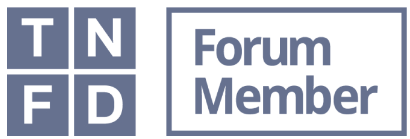
Governance
1.Monitoring
We promote sustainability management across the entire Group by reflecting in our business strategy our response to significant environment-related issues (including climate and nature-related risks and opportunities) that are highly relevant to our business, as well as initiatives that contribute to resolving these issues. These are deliberated and approved by the Group Management Meeting, the highest decision-making body for business execution. Furthermore, the Sustainability Committee, which meets at least twice a year, shares the policies on environmental issues deliberated and approved by the Group Management Meeting, formulates action plans to address issues within the Group, and monitors the progress.
The Board of Directors (meets monthly) receives reports on the activities of the Sustainability Committee and matters deliberated and approved by the Group Management Meeting, then supervises target setting, policies, and action plans.
* Skill Matrix.
https://www.j-front-retailing.com/english/company/governance/governance02.html#skillmatrix
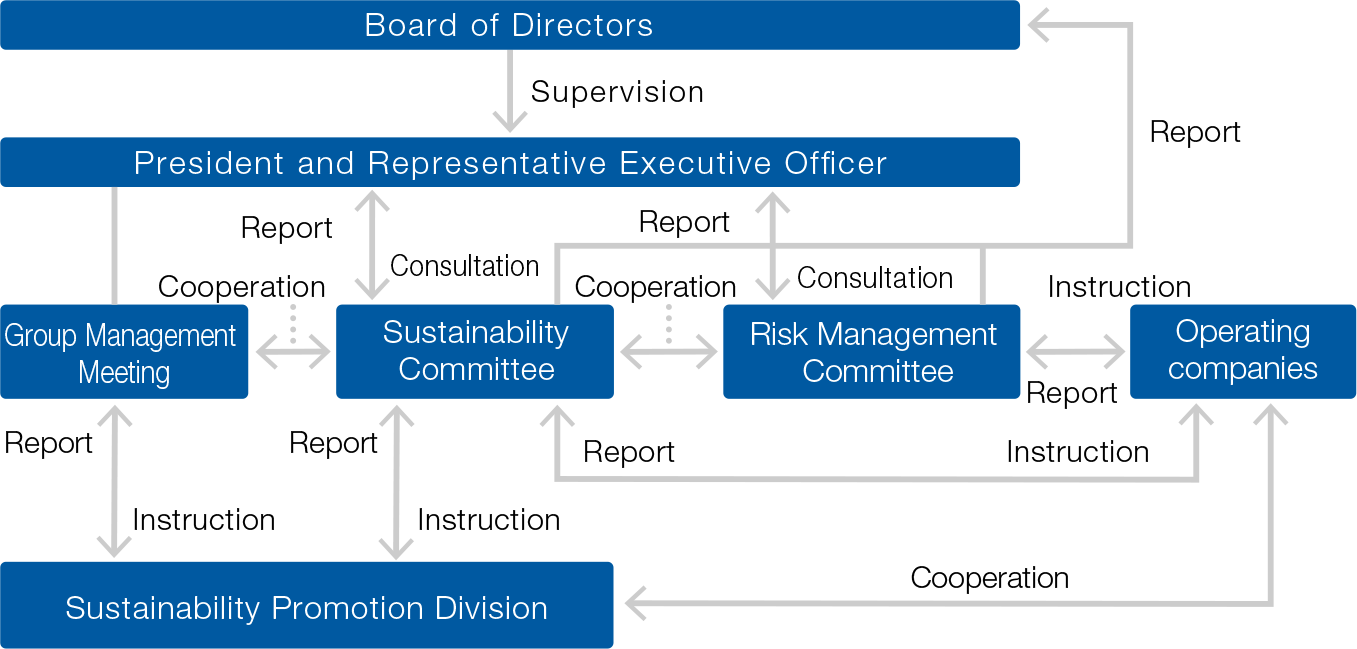
2.Management Structure
The President and Representative Executive Officer chairs the Group Management Meeting as well as the Risk Management Committee and the Sustainability Committee, which are both advisory panels under his or her direct control. The President thus bears final responsibility for management decisions related to environmental issues, including climate-related issues. Details of matters deliberated and approved by the Group Management Meeting and the Sustainability Committee are reported to the Board of Directors for final approval.
Major nature-related agenda item for the Sustainability Committee
|
FY2023 |
Sep |
●Lecture and discussion by external expert on the topic “Overview and Necessity of Biodiversity Response” |
|---|
Meeting bodies and their roles in the environmental management system
|
Meeting body and system |
Role |
|
|---|---|---|
|
Meeting body |
Board of Directors |
Supervises the progress of environment-related initiatives deliberated and approved by those who execute business. Meets monthly. |
|
Group Management Meeting |
Deliberates and approves policies and measures related to company-wide management as the highest decision-making body for business execution. Deliberates and approves company-wide management policies and other matters related to comprehensive risks and opportunities, including environment-related issues, as discussed by the Risk Management Committee and Sustainability Committee, and reports to the Board of Directors for approval. Meets weekly. |
|
|
Risk Management Committee |
Deliberates on the identification, evaluation, and response to comprehensive risks and opportunities, and monitors the risk responses of operating companies. Climate-related risks and opportunities are also integrated into the company-wide risk management framework and managed together with other risks. Deliberations by the Committee are reported to the Board of Directors. Held three times a year. |
|
|
Sustainability Committee |
Discusses specific measures to address more detailed issues related to sustainability, including environment-related issues deliberated and approved by the Group Management Meeting. Concerning climate-related issues, it monitors the progress of each operating company based on the Group's long-term plan and KGI/KPI, taking into account risks and opportunities. Dialogue also held with experts in climate-related issues. The contents of the discussions are reported to the Board of Directors. Held at least twice a year. |
|
|
Executing entity |
President and Representative Executive Officer |
Chairs the Group Management Meeting, and also the Risk Management Committee and the Sustainability Committee. Assumes the ultimate responsible for making management decisions on environment-related issues, including identifying, assessing, and responding to climate-related risks and opportunities, and promoting group-wide initiatives to resolve environment-related issues. |
|
Operating Companies |
Each operating company plans and implements specific measures to address environment-related issues based on the items approved by the Group Management Meeting and the deliberations of the Risk Management Committee and Sustainability Committee, and reports on the progress to the JFR Group's Risk Management Committee and Sustainability Committee. |
|
|
Sustainability Promotion Division |
Formulates and proposes Group policies and other measures to promote sustainability management. The division collects climate-related information on risks and opportunities, formulates the direction of medium- and long-term initiatives, and reports to the Group Management Meeting and the Sustainability Committee. |
|
Risk Management
1.Process for identifying and assessing nature-related risks and opportunities
The Company considers risk to be the starting point of strategy. We have defined risk as “uncertainty, both positive and negative, that affects the achievement of corporate management goals.” We believe that the appropriate handling of risk leads companies to sustainable growth.
With the recognition that nature-related risks and opportunities have a great impact on our business strategies, the Group identified and assessed both positive and negative aspects of climate-related risks and opportunities through the process shown below.
First, the Group extracted a comprehensive set of climate-related risks and opportunities exhaustively for each activity of the supply chain process: “product procurement,” “transportation and customer movement,” “in-stores sales,” “use of products and services,” and “disposal.” Next, we assessed them based on two criteria: “importance to the Group” and “importance to stakeholders.”
*See Strategy for details.
2.Management system for nature-related and other environmental risks
The Company is working to share environmental-related risks, including nature-related risks, with each of its operating companies by examining them in greater detail within the Sustainability Committee. Each operating company incorporates nature-related initiatives into their action plan and confirms the progress through discussions in meetings headed by the president of each operating company. Progress is monitored by the Group Management Meeting, the Risk Management Committee, and the Sustainability Committee, and is finally reported to the Board of Directors.
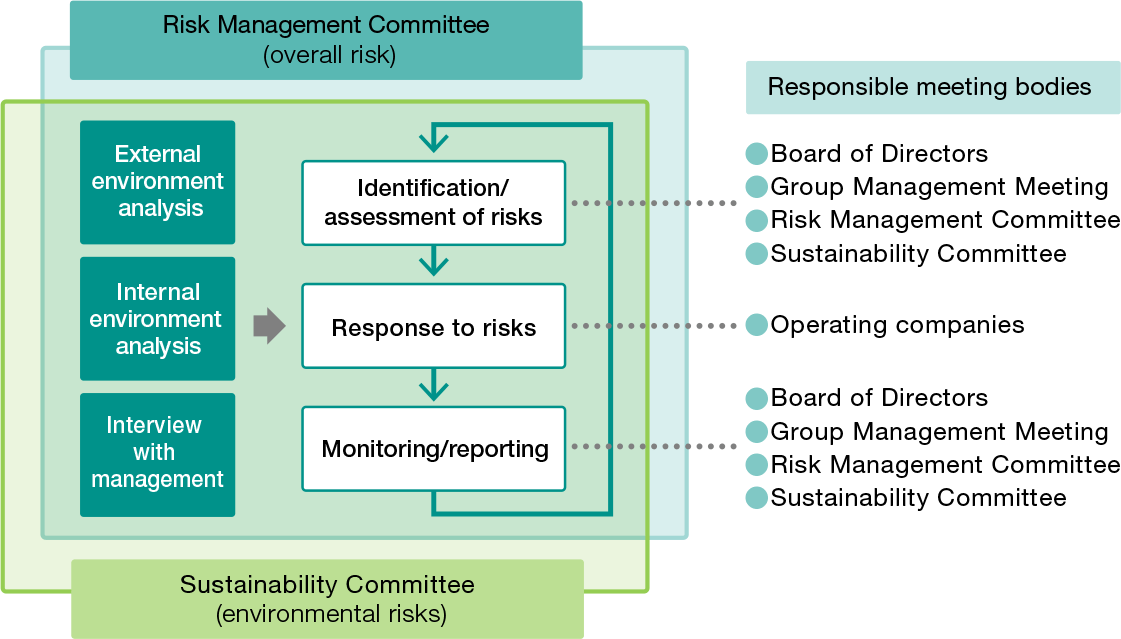
3.Integration into the company-wide risk management framework
Recognizing that risk management is critically important to corporate management, we have established a Risk Management Committee (meets three times a year) to manage all risks, including environmental risks, in an integrated company-wide manner. The committee deliberates on important matters such as identification and evaluation of risks and the determination of which risks will be reflected in strategy. Because we position risk as the starting point of strategy, we strive to link risk management to the enhancement of corporate value by aligning our strategy with risk.
Risks that are extremely important to the Group's management over the medium term are positioned as "critical risks" and serve as the starting point for our Medium-term Business Plan. Significant risks are further broken down into "annual risks," allowing us to clarify the risks to be addressed each year and prioritize countermeasures. One of our key risks is the "growing importance of environmental issues," and we review environmental risks and opportunities on an annual basis.
The deliberations of the Risk Management Committee are reported to the Group Management Meeting and shared with the Sustainability Committee. Additionally, the contents of discussions in these bodies, as well as matters approved by the Group Management Meeting, are reported to the Board of Directors (meets monthly). Under this supervisory structure, we reflect risk-related matters in the Group's strategy and implement appropriate measures.

Strategy
1.Dependency and impact on nature
Our Group is dependent on the many blessings of nature (ecosystem services), such as soil, forests, and a climate with four seasons, in addition to agricultural products, livestock products, marine products, wood, water and other resources. On the other hand, our business activities impact the natural environment in various ways, such as GHG emissions, waste emissions, and water discharge. The Company recognizes the importance of understanding and responding to the relationship between our business activities and the natural environment, specifically the “dependency” and “impact” of both.
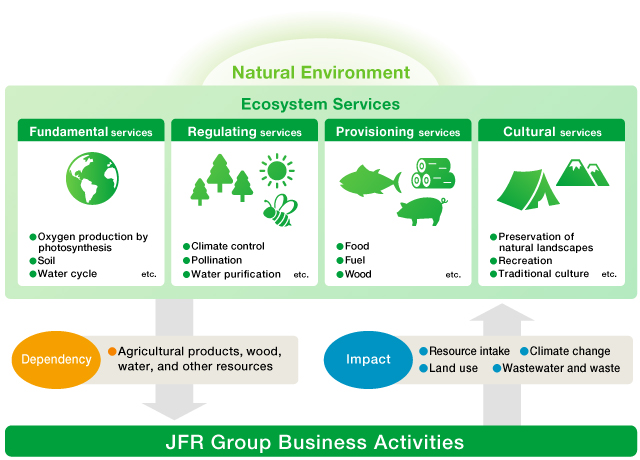
2.Taking into account the LEAP*3approach in assessments of nature-related issues
The LEAP Approach is an integrated process recommended by TNFD for assessing nature-related issues, including locating the interface with nature, evaluating dependencies and impacts on nature, and assessing risks/opportunities.
In FY2023, Daimaru Matsuzakaya Department Store, one of the Group's main operating companies, identified and assessed nature-related issues (dependencies/impacts, risks/opportunities) based on the LEAP approach for its 15 department stores located throughout Japan.
*3 LEAP : stands for the four-step process of Locate, Evaluate, Assess, and Prepare
①Appearance of dependencies and impacts <Locate>
The dependencies and impacts of the entire value chain in the department store business and the degree of dependencies/impacts on natural capital in direct operations (store operations and store development) and upstream value chain (procurement) were determined based on ENCORE, a tool recommended by TNFD to identify dependencies/impacts on nature. Heatmaps were created to determine the degree of dependence/impact on natural capital in the direct operations (store operations and store development) and upstream value chain (procurement).
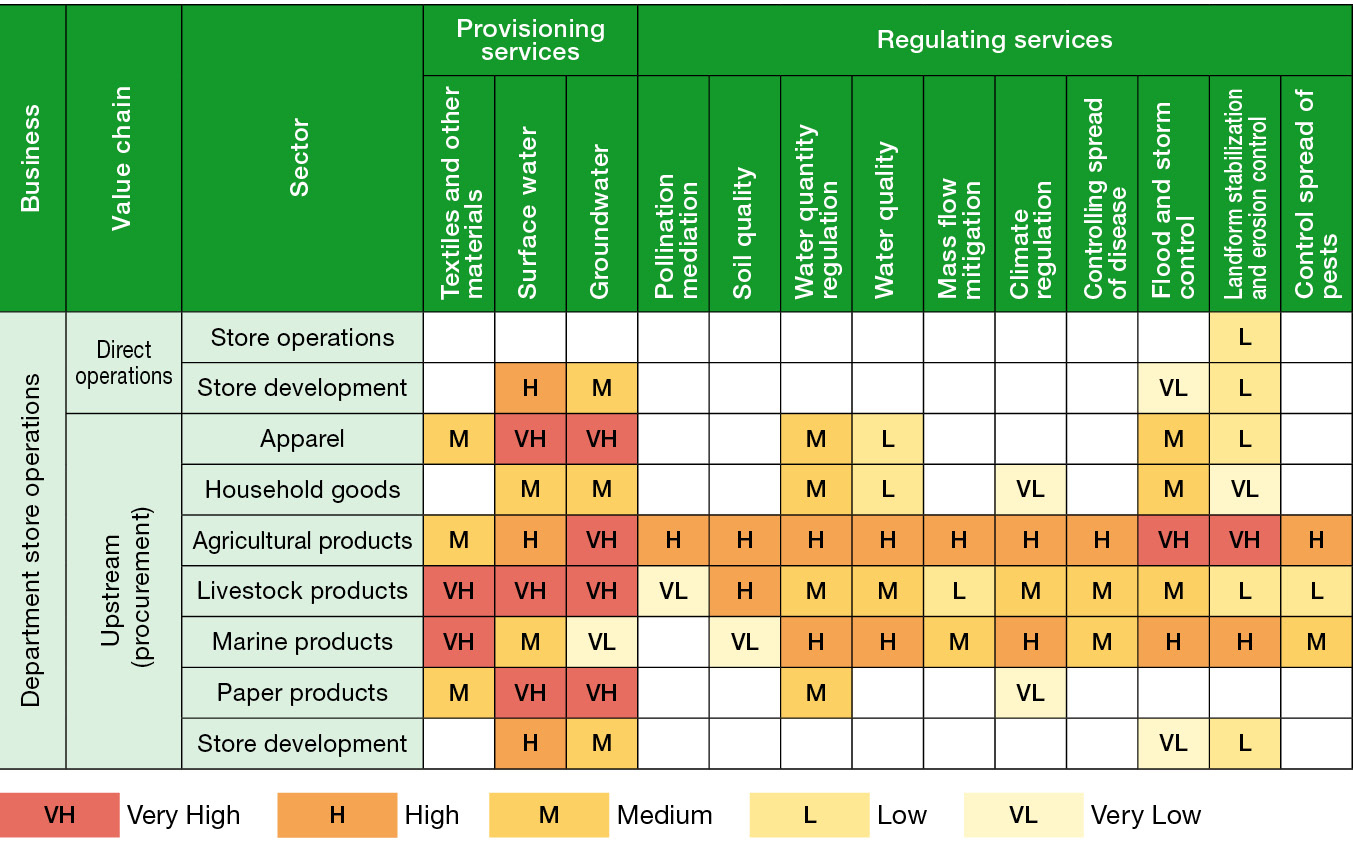
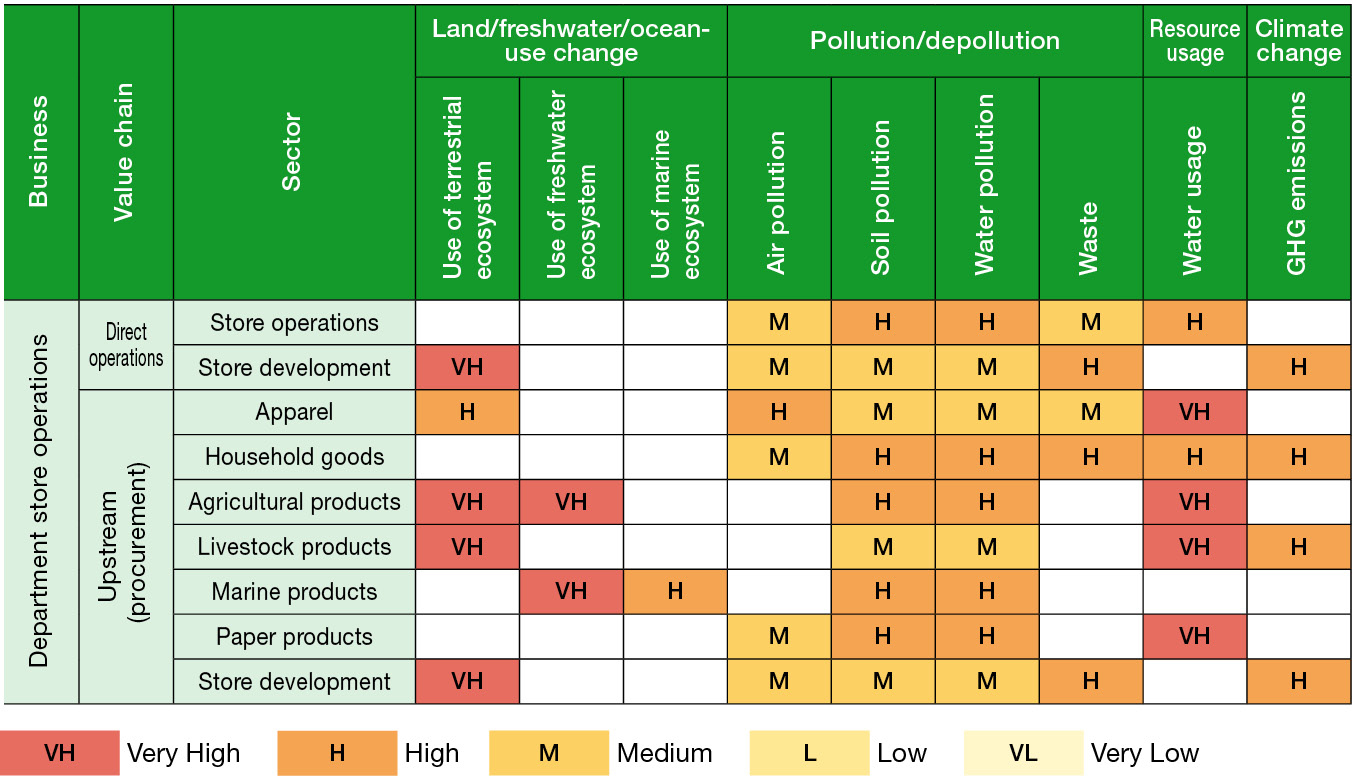
②Identification of stores to evaluate for risks/opportunities <Locate>
Using the Risk Filter Suite (ecosystem and water risk analysis tool) from WWF*4, Aqueduct (water risk analysis tool) from WRI*5, and other tools, we verified the state of ecosystems in areas where our stores are located. In addition, we evaluated the importance of each store location based on our own criteria (land and building ownership, sales volume, etc.). As a result, Daimaru Shinsaibashi was identified as a store of particular importance for biodiversity conservation.
*4 WWF (World Wide Fund for Nature): An environmental conservation organization active in more than 100 countries that works to restore the vanishing richness of biodiversity and to prevent global warming.
*5 WRI (World Resources Institute): An independent organization that conducts policy research and provides technical assistance on global environmental and development issues.
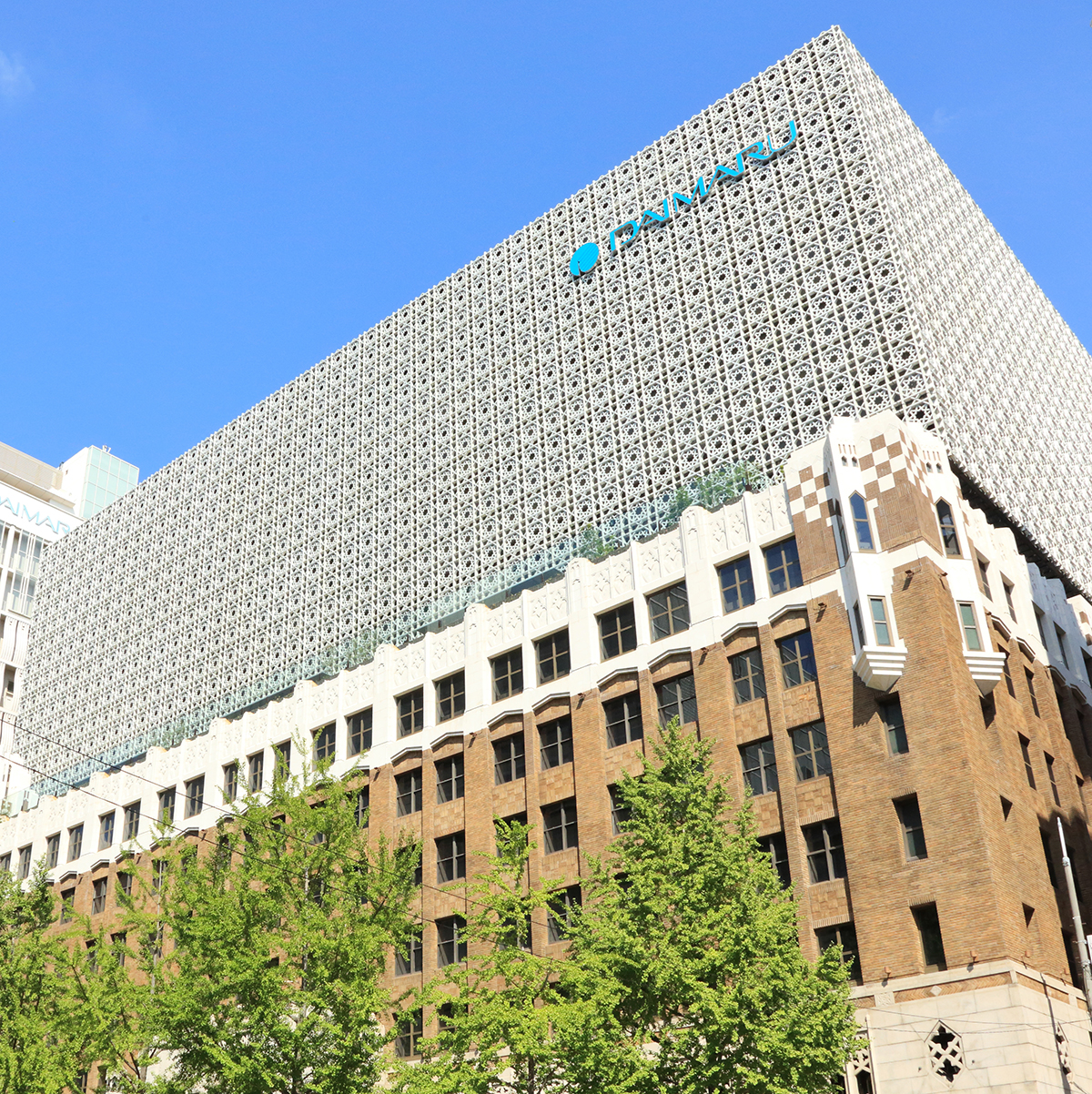
③Sorting out the factors behind dependencies and impacts on nature <Evaluate>
Of the business activities at Daimaru Shinsaibashi, we have sorted out the factors with significant dependencies and impacts on the ecosystem services in the value chain: “Store Development,” “Clothing and Food,” and “Packaging Materials.”
 |
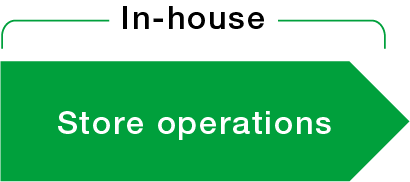 |
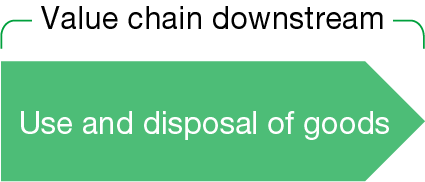 |
|||
Store Development |
Dependencies |
●Procurement of raw materials for construction ●Water usage |
●Fuel usage |
●Fuel usage |
|
|---|---|---|---|---|---|
Impacts |
●Land conversion and development ●Mineral resource extraction |
●Air pollution |
●Air pollution |
●Fuel usage |
|
Clothing and Food |
Dependencies |
●Use of soil, forests, and pastures for livestock feed and procurement of raw materials such as cotton and lumber |
●Fuel usage |
●Fuel usage |
●Water usage |
Impacts |
●Soil pollution due to such factors as excessive wood consumption and use of pesticides, deforestation, reduction of pastureland, land degradation, desertification |
●Air pollution |
●Air pollution |
●Microplastic runoff during laundering, water pollution |
|
Packaging Materials |
Dependencies |
●Procurement of raw materials for paper packaging ●Water usage ●Fuel usage ●Electricity usage |
●Fuel usage |
●Fuel usage |
|
Impacts |
●Deforestation due to excessive logging ●Energy usage ●GHG emissions |
●Air pollution |
●Waste emissions |
●Fuel usage |
|
④Assessment and response to risks and opportunities <Assess> <Prepare>
Based on the sorting out of dependencies and impacts on ecosystem services at Daimaru Shinsaibashi in steps (1) to (3), we identified and evaluated nature-related risks and opportunities that could affect our business activities, and discussed activities to address them. In addition, we qualitatively evaluated the impacts to our business activities on three levels (major, medium, minor) based on two criteria: “importance to our company” and “importance to our stakeholders.
Item |
Details of risks/opportunities |
Impact |
Details of activities |
||
|---|---|---|---|---|---|
Risk |
Physical |
Acute |
・ Decrease in revenues due to store closures caused by extreme weather and increased natural disasters |
Large |
●Strengthening the resilience of stores and offices through BCP development ●Improvement in disaster prevention performance of stores |
Chronic |
・ Increase in energy costs due to rising temperatures |
Medium |
●Replacement with high-efficiency energy-saving equipment at the right time |
||
|
・ Earnings instability due to a decrease in the number of agricultural and marine products handled owing to crop failures, lower quality, and reduced harvests ・ Decrease in number of customers visiting stores and changes in sales owing to rising temperatures and changing rainfall patterns |
Medium |
●Discussion and strategy development for the procurement risks of critical food raw material |
|||
Transition |
Policy and regulations |
・ Increase in costs due to tighter regulations on GHG emissions |
Medium |
●Reduction of GHG emissions through aggressive energy-saving measures in stores and increased switchover to renewable energy sources |
|
Market |
・ Increased difficulty in store development (exterior and interior design,including additions and renovations) and higher construction-related costs due to a shortage of building materials |
Small |
●Greater use of domestically produced thinned lumber |
||
・ Decrease in profits due to inability to meet growing consumer demand for sustainable products |
Large |
●Expansion of environmentally friendly products such as certified products ●Switchover to environmentally friendly packaging materials such as FSC certified products ●Promotion of smart wrapping and simplified packaging options |
|||
Reputation |
・ Loss of reputation due to inadequate sourcing of sustainably produced goods |
Medium |
●Expansion of certified products ●Smart delivery (reduction in the number of deliveries) |
||
・ Loss of reputation due to increased waste and lack of proper disposal |
Medium |
●Introduction of AI demand forecasting service to reduce food waste ●Composting community activities by employees to reduce food waste ●Appropriate response to the Plastic Resource Circulation Act |
|||
Opportunity |
Resource efficiency |
・ Reduction in costs associated with efficient water usage |
Small |
●Usage of rainwater and graywater ●Usage of water-saving equipment |
|
Products and services |
・ Increase in the property value of buildings due to real estate development with sustainable sourcing of materials and reduced energy use |
Large |
●Promoting the development of procurement rules and acquisition of various certifications (CASBEE, ZEB, etc.) and emphasizing them externally. |
||
・ Increase in revenues due to increased handling of certified/sustainably produced goods |
Large |
●Expansion of certified products ●Raising awareness and educating customers about certified products |
|||
Markets |
・ Continuation and maintenance of store operations due to mitigation of storms, typhoons, etc. |
Large |
●Establishment of environment for the enjoyment of ecosystem services (e.g., establish rules based on an understanding of location, vegetation, and climate characteristics) |
||
・ Increase in customer traffic to real estate development and retail operations (land use) that take biodiversity and landscape into consideration |
Medium |
●Implementation of rooftop greening and rooftop urban beekeeping |
|||
・ Growth of profits through acquisition of new customers by promoting a sustainable lifestyle that emphasizes resource circulation |
Medium |
●Expansion of circular businesses such as sharing and upcycling, including the fashion subscription service "AnotherADdress" ●Establishment of the joint venture, JFR & KOMEHYO PARTNERS Co., Ltd. in March 2025, with KOMEHYO Co., Ltd. (launch of reuse business) |
|||
Capital flow and financing |
・ Increase in financing capacity due to higher environmental value of buildings |
Large |
●Acquisition of environmental certification for newly developed properties ●Raising of funds through green bonds, etc. |
||
Reputation |
・ Improvement in reputation by providing rooftop gardens and other places for relaxation |
Medium |
●Rooftop greening and rooftop urban beekeeping |
||
・ Improvement in reputation by promoting recycling-oriented business |
Medium |
●Establishment of partnerships with other companies for resource recycling of waste plastics and food waste (e.g., POOL project, domestic SAF project, etc.) |
|||
Ecosystem protection, restoration, rehabilitation |
・ Reduction of compliance costs by improving traceability of products (especially risk commodities) |
Small |
●Strengthening of supplier engagement by conducting assessments, etc. |
||
Sustainable use of natural resources |
・ Improvement in store brand value through reduced use of paper products and increased use of alternative materials |
Small |
●Switching to environmentally friendly packaging materials such as FSC certified packaging ●Promotion of paperless packaging |
||
Metrics and Targets
The Company recognizes that climate change and the loss of biodiversity are inseparable issues. To achieve a comprehensive solutions to both, we have established metrics and targets to efficiently circulate resources and advance our initiatives accordingly.
Metrics and targets used by the JFR Group to manage nature-related risks and opportunities
Metrics |
Target year |
Description |
|---|---|---|
GHG emissions |
2050 |
Scope 1, 2, 3 net zero GHG emissions*1 |
2030 |
73% reduction of Scope 1, 2 GHG emissions (vs. FY2017)*2 |
|
Ratio of renewable energy used in business activities |
2050 |
100%*4 |
2040 |
90% |
|
2030 |
75% |
|
Food recycling rate |
2030 |
85% |
Development of environmentally friendly products |
2030 |
Expand transaction volume of environmentally friendly products, including certified products |
Percentage of newly developed properties with environmental certification |
2030 |
100% |
*1. Obtained SBT certification in FY2022 for Net Zero targets
*2. Obtained SBT certification in FY2021 for the "1.5℃ target" (60% reduction vs. FY2017 before the target was revised)
*3. Obtained SBT certification in FY2021 for "1.5℃ target"
*4. Joined RE100 in 2020
Survey on the Handling of Certified Label Products
Daimaru Matsuzakaya Department Stores conducted a survey in November 2024 targeting 90 business partners that handle textile products, cosmetics, and food items. The survey focused on their handling of certified label products that take into consideration biodiversity and human rights.
As a result, approx. 38% of the responding suppliers handled products with certification labels. However, many suppliers indicated that even if the products themselves do not have certification labels, they use certified raw materials, take environment and human rights considerations into account during the production processes, or have established their own certification standards.
Going forward, we will review the priorities of our initiatives and expand their scope. At the same time, we will engage in active communication, such as conducting biodiversity assessments targeting key suppliers, in order to enhance the effectiveness of our efforts toward a nature-positive approach. We will also strive to expand the range of the environmentally friendly products we handle so that our customers can contribute to the environment by purchasing our products and services.
Biodiversity Initiatives
Certification as a Nature-Friendly Site
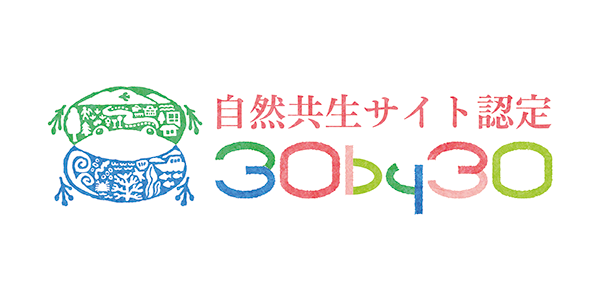
The Ministry of the Environment has designated "Yamaga Waguri no Sato," a project jointly undertaken by Hakata Daimaru's Kyushu Tenkentai and a group of Japanese chest-nut producers, as a "Nature Symbiosis Site" under its certification program for areas where biodiversity conservation is being promoted through private-sector initiatives. The designation was granted in March 2025. Yamaga Waguri no Sato is located in Yamaga City, Kumamoto Prefecture, and features chestnut orchards in mountainous valleys that retain their natural terrain. Unlike flatland chestnut orchards, these valley orchards support a rich variety of herbaceous plants and the organisms that inhabit them. During the chestnut flowering season from May to June, numerous insects, including Japanese honeybees, visit the orchards, contributing to pollination. Additionally, the site includes streams, where many wild birds, such as kingfishers, have been observed.
Going forward, we aim to expand the circle of biodiversity conservation through the development of new specialty products using Yamaga chestnuts and the creation of ecotourism initiatives.

Rooftop Greening - Landscape-Conscious Store Development
Daimaru Shinsaibashi's 7th floor terrace (110㎡) in the main building is a "garden" filled with Japanese ash trees, olive trees, and other plants, where visitors can walk around. On the rooftop is also a 900㎡ "green space". In addition, a green wall with elaborate stripes of greenery has been adopted on Taihoji-dori, the street that runs between the main building and Shinsaibashi PARCO. The greening initiatives are part of our proactive efforts to reduce CO2 emissions.

Rooftop Urban Beekeeping
In 2019, we launched the Shinsaibashi Honey Project. Beehives were installed on the roof top, which is approximately 900㎡ large and 60m above ground, for urban beekeeping. Approximately 200,000 bees fly out and collect nectar from flowers with-in a 3km radius. The bees' presence in the city contributes to maintaining the rich local ecosystem and to the revitalization of the pollination of crops and plants. Honey produced on the rooftop is sold as "Shin-saibashi Honey."
In addition, we hold events such as "honey extraction" in our store to provide opportunities for customers to think about the environment.
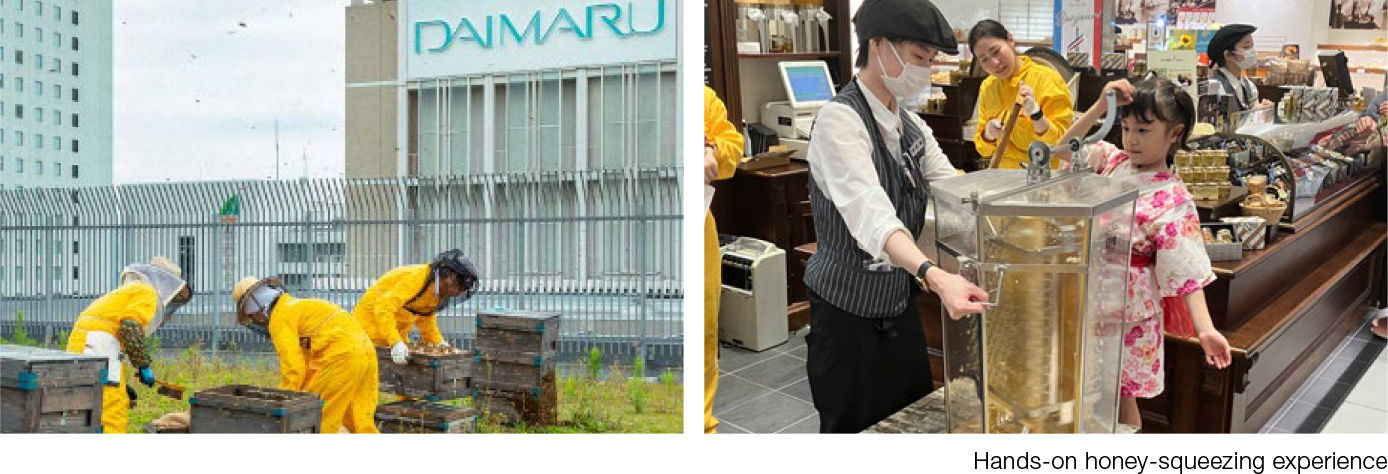
Composting - Reduction of Food Waste -
As part of Hakata Daimaru's "Compost Project," which began in 2022, we created a compost garden in front of the store (Pas-sage Square) in October 2024. The compost garden features baby greens, celery, stick broccoli, carrots, and other vegetables. In April 2025, we also held Spring Harvest Festival, where participants enjoyed sandwiches made with vegetables harvested from the garden. The soil in the planters is made from composted food waste collected from the employee cafeteria at Hakata Daimaru, contributing to efforts to reduce food waste.

Use of Environmentally Friendly Packaging Materials
In September 2019, Daimaru Matsuzakaya Department Stores switched to environmentally friendly packaging materials. Paper shopping bags-including those for food-and paper used for sales promotions have been replaced with paper sourced from responsibility managed forests, contributing to forest conser-vation.
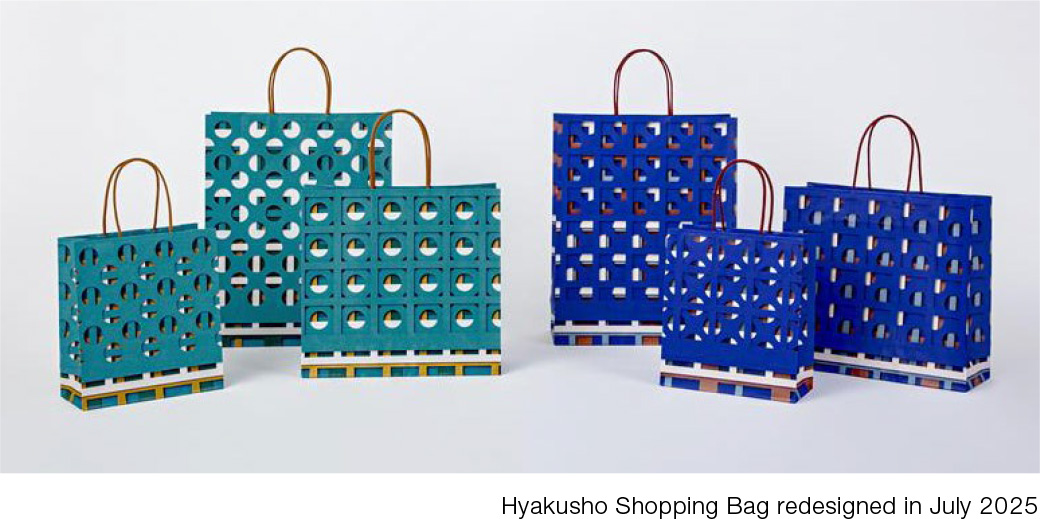
Acquisition of FSC®-CoC Certification
J. FRONT Design & Construction specializes in manufacturing custom furniture and store fixtures to meet the needs of its customers, mainly hotels, commercial facilities, and offices.In October 2023, the company acquired FSC®-Chain of Custody (CoC) certification*, which serves as proof that it properly manages and processes products made of wood from forests certified under Forest Management (FM certification) standards or other low-risk wood. This certification applies to their Osaka factory and their sales department, which acts as the customer interface for their products.
* Chain of Custody (CoC) certification guarantees the processing and distribution process of products made from FSC-certified wood until they reach the hands of consumers.
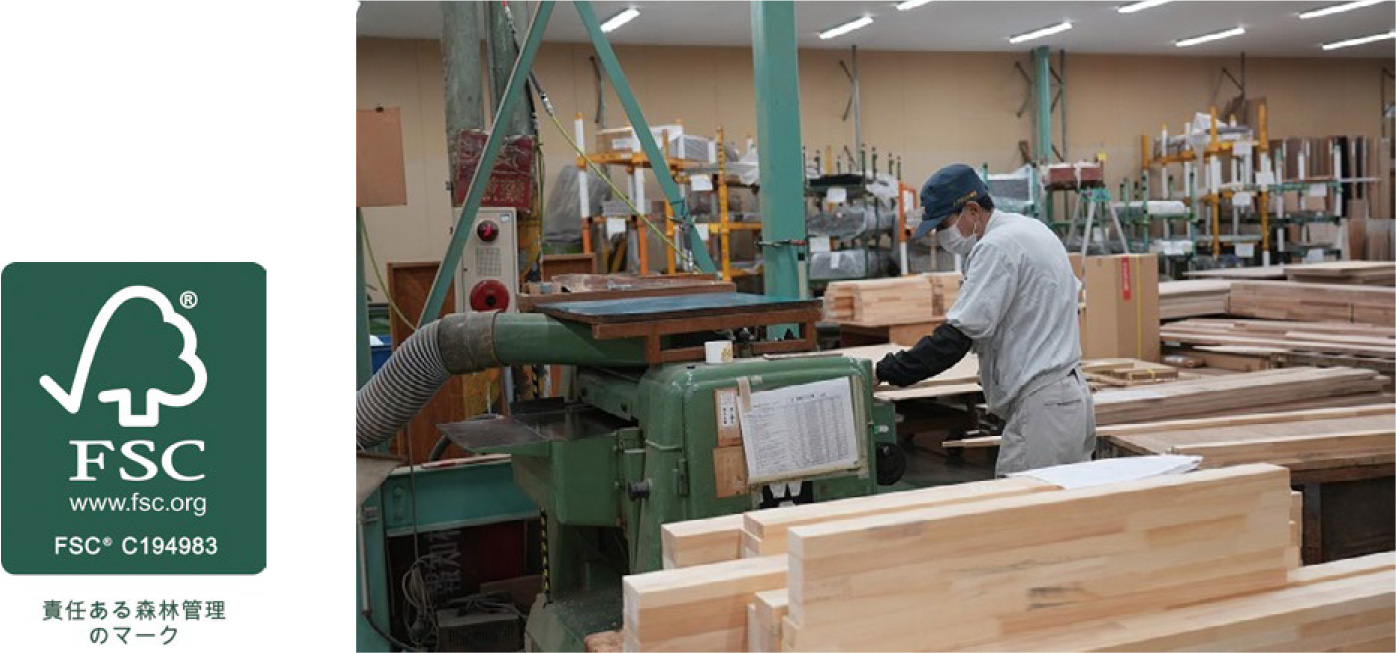

Use of Domestic Lumber
Effective use of domestic lumber is very important in maintaining the multifunc-tional nature of forests. J. Front Design & Construction, which specializes in inte-rior design for hotels and offices, has actively promoted the use of underutilized domestic timber in redevelopment projects for office buildings. With the support and understanding of clients, this timber has been proposed and adopted for use as interior finishing materials and large planters.
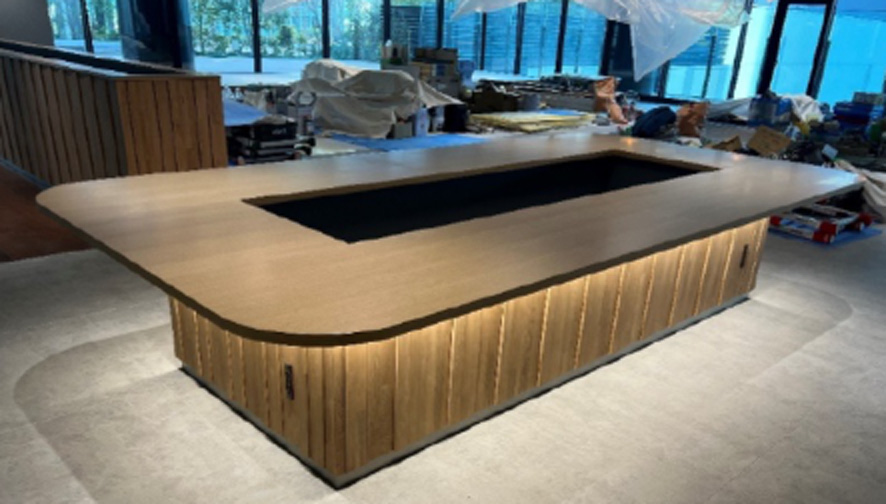
Adoption of Temporary System Panels for Demolition Work
In the past, temporary partitions used in department store renovation projects to section off construction areas were disposed of once the work was completed, with most of the materials put to good use as recyclable resources. In collaboration with Daimaru Matsuzakaya Department Stores, J. Front Design & Construction has taken this concept a step further by switching to a system panel construction method that does not generate waste.
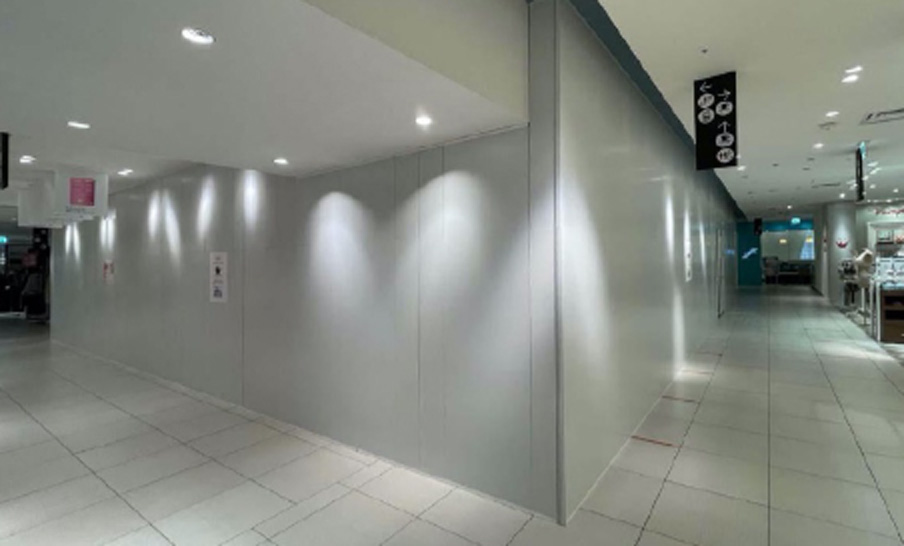
Use of Scrap Wood
At J. Front Design & Construction, leftover material such as wood scraps and unusable film cutoffs have been generated during interior construction work and the production of film mirror and fixtures. To utilize these materials, we have partnered with Osaka University of Arts to hold the "Breathing New Life into Scrap Wood" project every year since 2022. Starting in 2023, the range of materials expanded, including stone and metal, thanks to sponsorship from supplier companies. From 2024, Osaka Institute of Technology also joined the initiative, making it a joint project in which students, applying their rich imagination and flexible design skills, created unique works by engaging with the irregular and intriguing qualities of scrap.
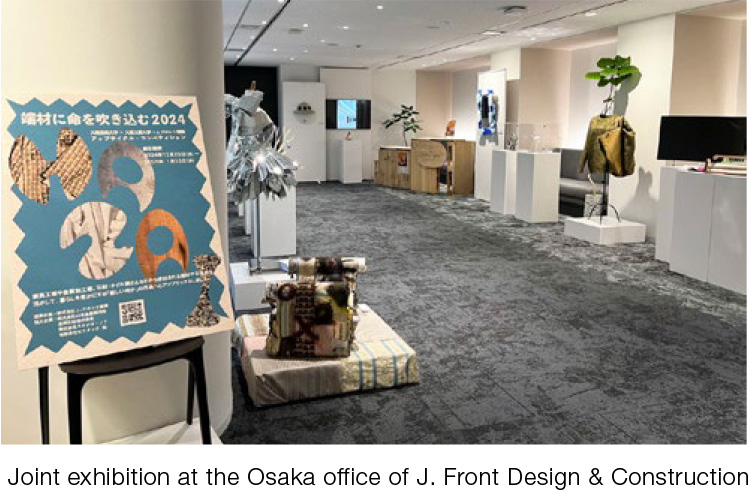
Water storage tank - Appropriate use of water
At the Daimru Shinsaibashi Store, a water storage tank measuring 3.7m high × 7m wide × 5m deep is installed on the basement floor to supply water to the toilets and water faucets in the building. The tank can hold the equivalent of water for 600 bathtubs, and the water can be supplied to local residents in the event of a disaster. On the B2 floor, we have installed a "kitchen wastewater purification system" in which wastewater is detoxified by microorganisms before being discharged into the sewage system, thereby contributing to preservation of marine and river environments.
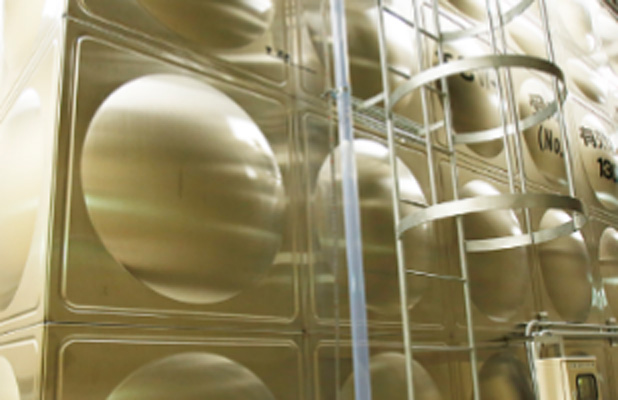
GINZA SIX was certified as an “Urban Oasis” under SEGES
In 2017, the GINZA SIX Garden, a rooftop garden of GINZA SIX, was certified as an Urban Oasis under the SEGES (Social and Environmental Green Evaluation System)* (administered by the Organization for Landscape and Urban Green Infrastructure), which recognizes comfortable and attractive urban green areas.
The GINZA SIX Garden, an about 4,000-square-meter rooftop garden, is located on the roof of the about 56-meter-high building with 13 floors above ground. A green area of approximately 2,200 square meters, which accounts for about 56% of the rooftop garden, was newly created. Our large-scale greening efforts in the prime downtown location were highly recognized and we obtained such certification.
* SEGES (Social and Environmental Green Evaluation System):
A system to recognize and certify outstanding green areas of the companies that contribute to society and the environment through greening activities
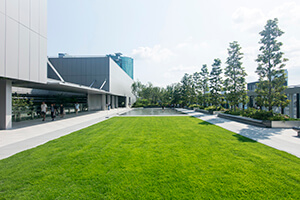
Creating a society that co-exists with the environment
-
Aiming to Achieve Net Zero by 2050
-
Environment Management System
-
Information Disclosure in Line with TCFD Recommendations
-
The Circular Economy the Group aims to create
-
Proposal for Environment-Friendly Lifestyles
-
Reduction of Wastes and Water Usage
-
Information Disclosure in line with TNFD Recommendations (Biodiversity Conservation)
-
Environmental Data
-
Acquisition of Third-Party Assurance
